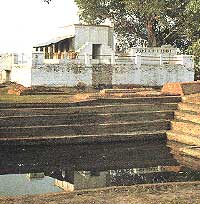Drowning the Buddha's birthing pool
The Guardian Post
Indian dam may
submerge Buddha's Nepal birthplace
Lumbini -- For more than 2,500
years Lumbini, a small, unremarkable village in the foothills of the Himalayas, has been
revered as a holy site. It was here in 623BC that Siddhartha Gautama, better known as Lord
Buddha, was born in a pleasant garden next to a pond. After 29 years as a prince,
Siddhartha renounced his luxurious existence and set off on the journey that eventually
led him to enlightenment.
 But the
village in Nepal is now at the centre of a bitter dispute. Just over the border, the
Indian government has begun building a dam, intended, it says, to stop Indian villages
being flooded every year during the monsoon.
But the
village in Nepal is now at the centre of a bitter dispute. Just over the border, the
Indian government has begun building a dam, intended, it says, to stop Indian villages
being flooded every year during the monsoon.
But the authorities in Nepal, who were
delighted when Unesco listed Lumbini as a world heritage site in 1997, say the dam is
likely to wash Bud dha's birthplace off the map. Opposition MPs have gone even further,
scenting a conspiracy. India has long claimed that Buddha's actual birthplace was not
Lumbini but the Indian village of Pipprahawa, two miles down the road.
"The construction of this barrage is
a well-designed conspiracy of India to inundate the birthplace of Lord Buddha and create
another fake Lumbini somewhere in India," Gokarna Bista, of Nepal's Communist party
opposition, said last week.
Last week the Nepalese water minister,
Bijaya Gachchedar, said the government had raised the issue through diplomatic channels
and asked the Indian government to stop work on the barrage.
India began building the dam, six metres
high, across the Danav and Danda rivers four months ago, 200 metres from the Nepalese
border. The Nepalese said India had broken international laws which forbid such
constructions within five miles of any border. The entire region on their side would be
flooded, they said. India seems to have stopped work.
Unesco is keeping a close watch on
events. Its spokeswoman in Kathmandu said: "This is a very sensitive issue. It
involves two different coun tries, religion and cross-border issues. We are just observing
until either government requests our help." Before its listing in 1997 there was
little to indicate that Lumbini was a site sacred to one of the world's great religions.
The village was an hour's bumpy ride on
an earth road road from the nearest town, Bhairawa.
Once there, visitors could walk round the
sacred pond where the Buddha's mother, Maya Devi, bathed before giving birth. A
commemorative pillar erected by the Indian emperor Ashoka on a pilgrimage to Lumbini in
245BC has also survived. It was dug up in the 1890s.
But the great sal (forest) which used to
surround the area has disappeared, as have the tigers that hunted in the border region in
the days of the Raj. Excavations by British archaeologists earlier this year seemed to
confirm the validity of Nepal's claim to the birthplace. They found ancient pieces of
pottery in nearby Tilaurakot, once the capital of the Kapilavastu empire, which the
Buddha's father ruled.
Since Unesco listed Lumbini the Nepalese
government has built several monasteries, a museum and a library. It wants to make the
village an international pilgrimage centre.